








MIDWEEK UPDATE 22 JULY 2020    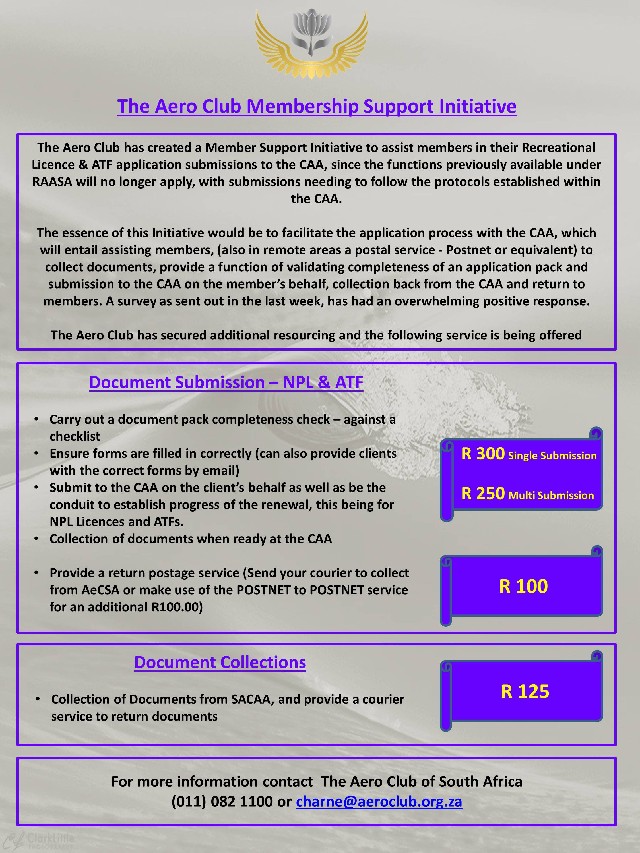  COVID 19 REGULATIONS AND INITIATIVES AND AEROCLUB NEWS  AERO CLUB COMMUNIQUE JULY 2020 # 3 Status on GA / RA flight operations in Level 3 - Phase 2 Update As indicated in the last communique, we have been working with the CAA on further practical concessions and, as per the link below, is the General Notice update that has extended our operations to enable refuelling stops during proficiency flights, as well as being able to hold events related to our sport / recreation given that there is a suitable Standard Operation Procedure (SOP) defined. This will be applicable to Aviation Recreation Organisations (AROs) and the normal event notification documentation will also be applicable for submission to the CAA. As also reported in the last communique on ATF frustrations and delays and your input to your sections on issues you have experienced, we have as the Aero Club, collated this information and submitted a letter last Friday to the CAA for them to review. The CAA have in the interim also recognised these issues and have made work in solving them and also released a communication in this regard over the last weekend - see link below, with contact details to assist in solving issues. We have seen in the mean time in the last week work being done at the CAA to improve the service in this regard. Will keep you posted on further developments. www.aeroclub.blueboxonline.com/? www.caa.co.za/Documents/Temporary%20Documents/Industry%20Communique%20%E2%80%93%20key%20information%20on%20various%20service%20areas.pdf   GUIDANCE FOR GENERAL AVIATION AND AVIATION RECREATION PROFICIENCY FLIGHTS This GENERAL NOTICE replaces NOTICE # GAD-2020/003 of 3 July 2020. 1. Background Due to the Covid-19 lockdown effect on Aviation operations and more specifically the effect on maintaining pilot proficiency, this notice applies to: (a) General Aviation. Part 1 Definition: "General Aviation Operation" means an aircraft operation other than a commercial air transport, air ambulance or aerial work operation; (b) Recreation Aviation. Part 1 Definition: "Aviation Recreation" means flying microlight, glider, balloon, gyroplane, hang-glider, paraglider, model aircraft, light sport aeroplane, touring motor glider, parachute or involvement in aviation events; 2. Further directions published - 1 July 2020 (Government Gazette 43493 of 1 July 2020) 2.1. General Aviation (a) All aerial work is permitted for the following will be permitted for the following purposes: • agricultural spraying, seeding and dusting; • cloud spraying, seeding and dusting; • culling; • construction; o aerial harvesting; • aerial patrol, observation and survey; • aerial advertisement, including banner towing and other towing of objects; • search and rescue; • aerial recording by photographic or electronic means; • fire spotting, control and fighting; and • spraying, seeding or dusting other than for agricultural purposes and clouds. b) Aerial Work operations contained in the paragraph a) above must be read in terms of the issuance of an Air Service License and an Aerial Operators Certificate for a service rendered i.e. Commercial Flight Operations. For further information please contact the following e-mail address: FOD_Aerial_Work@caa.co.za c) General Aviation operations with a privately operated "own aircraft" as an integral part of an Essential service business flight for the exclusive benefit of the owner of the aircraft and business in terms of Part 91 i.e. Non-Commercial Flight Operations. For further information please contact the following e-mail address: laubscherp@caa.co.za 2.2. General Aviation is permitted for the following purposes: (a) Proficiency flights provided that the flight is authorised by the South African Civil Aviation Authority and remains within the general flying area, airfield or airport boundaries; (b) For purposes of paragraph (a) above, and as it applies to General Aviation Aircraft; i) The application process in paragraph 4. below applies; ii) All aircraft airworthiness requirements and Pilot licensing requirements must be valid and current at the time of the intended flight. iii) VFR by day flights only; iv) Arrival and Departure aerodrome remains the same for the flight - refuelling stops are allowed; and v) Single pilot or essential crew only, no passengers permitted. 2.3 Recreational aviation is permitted for proficiency flights provided that the flight is authorised by the South Africa Civil Aviation Authority and remains within the general flying area, airfield or airport boundaries. In the case of model aircraft, the procedure as published by the SAMAA and as applicable to the registered clubs contained in ENR 5.5 will apply. (a) For purposes of paragraph 2.3 above, and as it applies to Recreational Aviation Aircraft: i) The application process in paragraph 4. below applies; ii) All aircraft airworthiness requirements and Pilot licensing requirements need to be up to date and current for approval of the above flights; iii) VFR by day flights only; iv) Arrival and Departure aerodrome or site remains the same for the flight, with latitude granted for off base refuelling or event participation under the approved applicable SOP; and; v) In the case of non-powered flights, the approved applicable SOP will apply. vi) Single pilot only, no passengers permitted. 2.4. For the purpose of proficiency flights in 2.2. and 2.3. above a pilot may request that a nominated and current senior mentor pilot or instructor be permitted to accompany the applicant as a safety pilot in order to promote proficiency and safety during such flights. a) General or Recreational Aviation operations other than those listed in this General Notice or covered under the notices below are NOT permitted. b) In the case of parachuting and hang or paragliding, tandem operations are NO permitted. 3. This General Notice applies in addition to the existing General Notice's below: a) General Notice # GAD-2020/001: Maintenance Related Flights- Aircraft Engine and System Health. Continued airworthiness flights (aircraft engine and system health) as recommended by aircraft and engine manufacturers may continue in accordance with the process in 3. below; or b) General Notice #GAD-2020/002: Guidance for Positioning Flights. Aircraft positioning flights may continue in accordance with the process in 3. below; or c) Flights covered by the Government Gazette Notice No. 43375 inclusive of Essential Service and Business flights which are conducted in terms of Part 91 and Part 94 of the Civil Aviation Regulations may continue, and must comply with the procedure contained in NOTAM A2116/20A02 as it was effective 3 July 2020, and may be amended from time to time. 4. Process to be followed: i. Each owner/pilot requesting a flight to be undertaken under the applicability of this Notice will be required to complete a flight request form that is accessible on the websites of the Aero Club of South Africa www.aeroclub.org.za, and the Commercial Aviation Association www.caasa.co.za (This will include a Covid-19 compliance form). ii. Once the form has been completed, the requestor will be prompted to submit the relevant pilot and aircraft documentation and will be advised of further procedure iii. An internal SACAA Authorisation process will follow where after the automated system will notify the owner/pilot of the outcome and further process to follow. iv. Website application and login detail required for registration of the intended flight and related detail will be provided. v. The CAA will be provided with a daily register of all flights undertaken against approvals issued by the automated system. a) Adherence to general COVID - 19 regulations at all times, the measures outlined by the South African Government to reduce the risk of the spread of COVID-19, such as social distancing, personal hygiene and minimising travel remain applicable, and pilots and operators undertaking flights on the basis permitted here must observe these. All operators must submit a Covid-19 compliance form as part of the flight request as defined in 1 a) above b) Compliance with the Civil Aviation Regulations 2011 The SACAA has the responsibility to monitor compliance in civil aviation activities carried out in South Africa. This extends to the monitoring and enforcement of compliance with the Regulations and Directions issued pursuant to the declaration of a National Disaster made on 15 March 2020 in terms of section 27 of the Disaster Management Act, 2002 (Act No. 57 of 2002), as applicable to the aviation industry. Non-compliance to the Civil Aviation Regulations, 2011 have the following consequences: i. 185.01.1(1) Any person who commits an offence, or contravenes these Regulations, may be subjected to administrative or criminal action in terms of this Part. ii. 185.01.2 A person commits an offence if that person- (a) hinders or obstructs an authorised officer, inspector or authorised person in the exercise of his or her powers or the performance of his or her duties; iii. (m) contravenes any provision of the [Civil Aviation] Act and these Regulations. Issued by the South African Civil Aviation Authority (SACAA) NEIL DE LANGE 17 July 2020 SENIOR MANAGER GENERAL AVIATION   CORONA VIRUS AND AVIATION EVENTS Due to Covid 19 and regulations regulating travelling as well as restrictions controlling the number of people congregating together, no aviation events will take place in the foreseeable future. Pilot's Post will advise our readers as soon as this changes. Chapter 322 Monthly Zoom Meeting. PLEASE GO TO www.youtube.com/channel/UCCuRVZAGodT6sztTeXBGeMw and subscribe to our YouTube channel   CENTURY AVIONICS OFFER OUR CLIENT THE SERVICE THEY CAME TO EXPECT 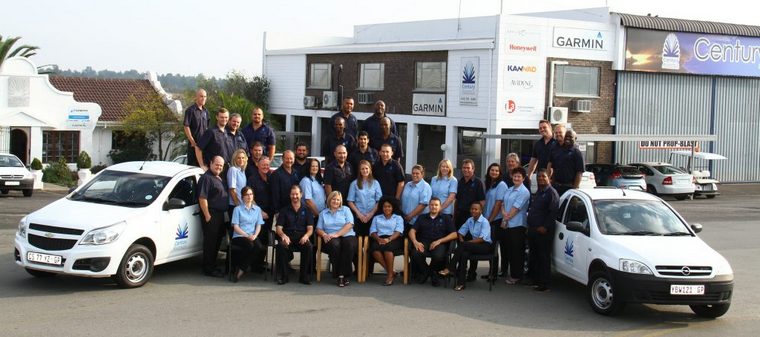 At Century Avionics, we regard our customers and staff members as the key players of our team. It goes without saying that your health and safety, as well as that of our team, is our highest priority. Photo © Century Avionics. Century Avionics is a proud supporter of events and showcasing our latest suppliers' products to our clients. Unfortunately, due to the Covid-19 virus the following events have been cancelled for the year: - AeroSA (8-10 July 2021) - Nampo (Virtual Event held between 9-12 September) - Africa Aerospace and Defence (21 - 25 September 2022)  LEONARDO: US EMS OPERATOR CONTRACTS FOR FIRST IFR-CERTIFIED AW119 IN THE CIVIL MARKET ALLOWING SAFER OPERATIONS IN CHALLENGING WEATHER CONDITIONS  The world's first fully FAA IFR-certified single engine in decades, the type allows safe operations in low visibility and challenging weather conditions combined with high performance and cabin space while keeping single engine economics. Photo © Leonardo The contract marks the first sale for the FAA certified IFR capable AW119 in the civil market and for emergency medical service roles. The type is the first single engine helicopter in decades to fully meet current IFR requirements without compromise, allowing pilots to operate the aircraft safely in low visibility and challenging weather conditions, thanks to advanced avionics by Genesys Aerosystems and redundant flight systems. The IFR-capable AW119 adds one more option and an ideal IFR entry point for commercial and public service operators who seek for the highest level of safety and performance in demanding conditions while keeping single engine economics. This combines with the AW119's unique light-twin like multiple redundancies of critical systems and cabin space delivering outstanding reliability and safety. The AW119 has met high standards of operational requirements and mission effectiveness - including NVG capability - since the first aircraft was delivered to Life Link III in early 2014. Life Link III's IFR AW119 will feature a special cabin interior with an articulated patient loading system, ensuring full patient body access for two medical professionals on board. This latest sale represents the growing share of Leonardo's helicopters in the North American EMS market, which now totals more than 113 across a fleet of AW119s, AW109s, AW169s and AW139s.  ROSTEC MADE THE FIRST CIVILIAN MI-8AMT ARCTIC HELICOPTER 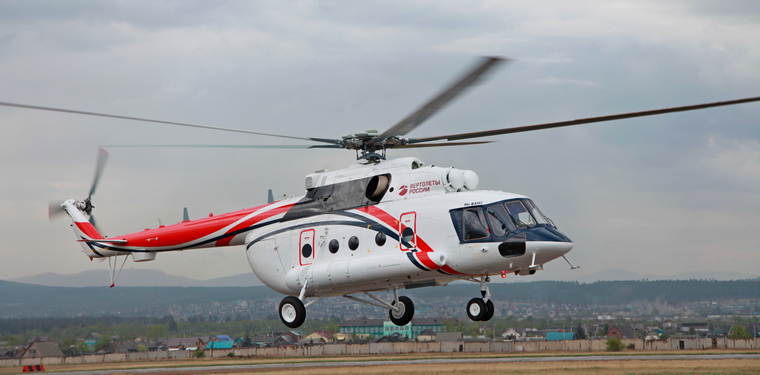 Russian Helicopters holding company (part of Rostec State Corporation) started serial production of Mi-8AMT Arctic helicopters for civilian customers. Ulan-Ude Aviation Plant made the first rotorcraft which is ready to start operation. Photo © Rostec The system for heating transmission parts is complemented by an improved system for thermal protection of the cargo cabin and special thermal insulation shutters in sliding doors and cockpit doors. Special cover protects the helicopter from low temperatures, high humidity and strong winds, if it is deployed without a hangar for a long time. The helicopter systems have Teflon hoses, which are resistant to freezing temperatures, instead of rubber hoses. The helicopter is equipped with two additional fuel tanks, which allow it to fly long distances. This in very important for northern districts with low population density. The Arctic version of Mi-8AMT can fly up to 1,400 km. An emergency floatation system can also be installed on the helicopter to fly over a vast area of waters in the Arctic. When the helicopter was designed, great attention was given to ensuring that it is capable of flying over the Arctic terrain with few features, in the conditions of polar night, harsh weather and when satellite and radio signals are lost. For that purpose, the rotorcraft is equipped with a special navigation complex. The complex includes several navigation systems for locating the helicopter, a radar with horizontal and vertical sweep of information on the weather, a digital autopilot and radio stations with a wide range of frequencies. The helicopter is capable of automated hovering, flying a planned hovering route and landing. The navigation system considerably reduces the load on the crew and ensures greater safety of the flight.  VOLTAERO PARTNERS WITH KINECTAIR TO DEVELOP CLEAN, ON-DEMAND REGIONAL FLIGHT SERVICES WITH THE CASSIO HYBRID-ELECTRIC AIRCRAFT 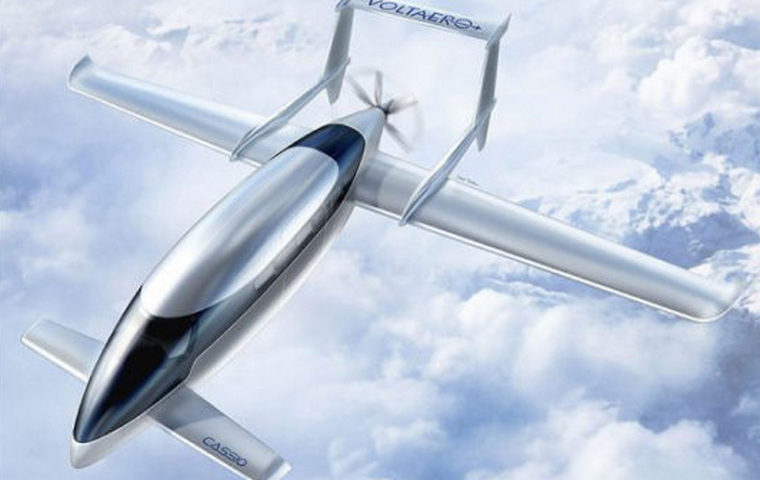 This cooperation foresees Cassio aircraft integrated with KinectAir's short-haul infrastructure, applying artificial intelligence to balance passenger demand with air transport availability. KinectAir's software platform will interface directly with Cassio's "intelligent cockpit." "The KinectAir collaboration opens exciting opportunities, combining the full benefit of our Cassio aircraft's low-noise, environmentally-friendly flights with an app that offers an accessible, affordable, sustainable and safe way to travel regionally by air," explained Jean Botti, VoltAero's CEO and Chief Technology Officer. Botti added that ensuring regional air service is more important today than ever, especially when economically-challenged airlines around the world are abandoning shorter routes - threatening air links that serve as vital lifelines to thousands of communities. VoltAero is developing a family of airplanes that use the company's proprietary hybrid-electric power module. Featuring a sleek, aerodynamically optimized design, Cassio will fly at 200 knot-cruise speeds (360 kilometers per hour) out to flight ranges of 800 miles (1,300 kilometers). Available in three versions with four to 10 seats, the aircraft are designed to take off and land in distances of less than 1,800 feet (550 meters), thereby opening the use of runways typically available at local and regional airports. Cassio deliveries will begin in late 2022. The aircraft will be produced on a purpose-built final assembly line in the Nouvelle Aquitaine region of southwest France, with licensed production opportunities pursued in North America and Asia.  BOEING COMPLETES HELICOPTER DELIVERIES TO THE INDIAN AIR FORCE 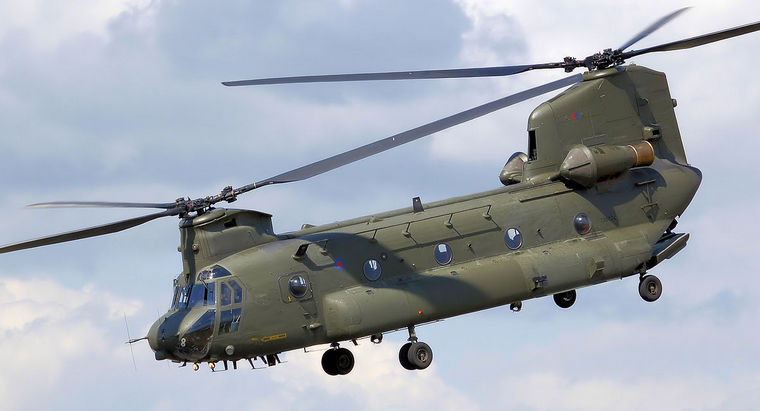 Boeing [NYSE: BA] has completed delivery of all new AH-64E Apache and CH-47F(I) Chinook military helicopters to the Indian Air Force (IAF). The final five of the 22 Apache attack helicopters were handed over to the IAF at Air Force Station, Hindan. Earlier in March, Boeing handed over the last five of 15 CH-47F(I) Chinook heavy-lift helicopters to the IAF. Photo © Boeing India is one of 17 nations to select the Apache and has the most advanced variant, the AH-64E Apache that is also flown by the U.S. and many other countries. The AH-64E Apache is designed and equipped with an open systems architecture including the latest communications, navigation, sensor and weapon systems. It has an improved Modernized Target Acquisition Designation System that provides day, night and all-weather target information, as well as night vision navigation capability. In addition to classifying air and ground targets, the Fire Control Radar has been updated to operate in the maritime environment. It is uniquely suited to meet a commander's needs, including reconnaissance, security, peacekeeping operations, and lethal attack, across myriad environments - without reconfiguration. Twenty defence forces around the world either have Chinooks in service, or are on contract to receive them. The iconic tandem-rotor helicopter has been the world's most reliable and efficient heavy-lift helicopter for more than 50 years, allowing customers to operate in climatic (hot), altitude (high), and crosswind conditions that typically keep other helicopters from flying. The CH-47F(I) Chinook contains a modern machined airframe, a common avionics architecture system (CAAS) cockpit, and a digital automatic flight control system (DAFCS). Those innovations and technologies will help the Indian Air Force meet evolving mission demands, maximize interoperability, and reduce lifecycle costs. The Indian Ministry of Defence finalized its order with Boeing for the production, training and support of 22 AH-64E Apache and 15 CH-47F(I) Chinook helicopters in September 2015. Earlier this year, India and the U.S. signed a contract for the acquisition of six Apaches for the Indian Army during U.S. President Donald Trump's visit to New Delhi. Boeing's joint venture in Hyderabad, Tata Boeing Aerospace Limited (TBAL) has been producing aero-structures for the AH-64 Apache helicopter for both US Army and international customers. TBAL marks a major step towards the co-development of integrated systems in aerospace and defence in India. Boeing's suppliers in India are manufacturing critical systems and components for the Chinooks, including the crown and tailcone assembly by Tata Advanced Systems and the ramp and aft pylon by Dynamatic Technologies. Boeing today works with over 200 suppliers and partners in the country in support of "Make in India" and "Skill India."  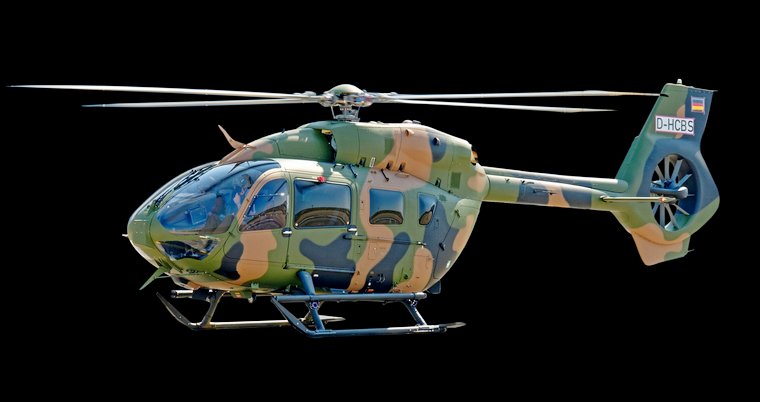 Airbus Helicopters has joined hands with over 20 Australian partners to form Team Nightjar, as the consortium launches its solution to Project LAND 2097 Phase 4. Under this Project, the Commonwealth of Australia is seeking a fleet of helicopters to support the Australian Defence Force's Special Operations. Photo © Airbus. In response to the Commonwealth of Australia's request for proposal for a four-tonne class, rapidly deployable, multi-role helicopter for the Australian Special Forces, Team Nightjar will be offering a fleet of the highly capable Airbus H145M and in-country support. The local consortium will deliver world leading training solutions, empower indigenous participation and enable rapid design and delivery of enhancements throughout the programme's lifetime. "We believe these capabilities will greatly enhance the core offering of the very capable H145M helicopter, while providing local jobs, technology transfer and export opportunities." The light twin-engine aircraft is an operationally proven, affordable and low-risk option for Australia, complementing the MRH90 Taipan with improved mobility and situational awareness for special operations. By virtue of its compact size, the H145M will be optimised for operations within dense urban terrain and will be rapidly deployable via a C-17A Globemaster. The H145M is tried and tested and is gaining popularity among defence forces due to its excellent price-performance ratio and the short delivery time, counting military forces in Germany, Hungary, Luxembourg, Serbia and Thailand as customers. In particular, the H145M is today supporting special operations roles with the German Armed Forces (Bundeswehr) with mission readiness of above 99%, delivering safety and superior power and payload. Airbus has nearly two decades of presence in Australia, building extensive local industrial capabilities and network, in support of the country's defence and commercial aviation. With a strong local team of more than 1,500 employees working across 23 sites for civil and military fixed-wing and rotary wing aircraft, the company has injected over A$1.7 billion of activities into the Australian aerospace industry, including A$100 million of direct investments from ARH Tiger and MRH90 projects.  BOEING AND U.S. AIR FORCE INK HISTORIC DEAL FOR F-15EX FIGHTER JET 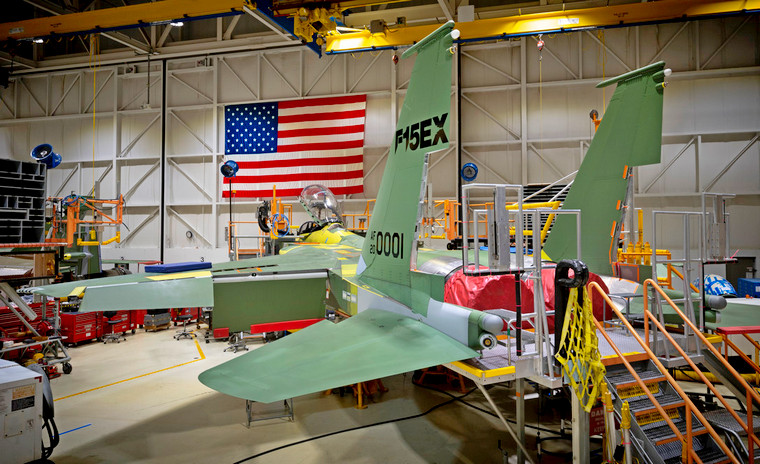 The U.S. Air Force is also announcing the overall Indefinite Delivery Indefinite Quantity contract with a ceiling value of nearly $23 billion for F-15EX. "The F-15EX is the most advanced version of the F-15 ever built, due in large part to its digital backbone," said Lori Schneider, Boeing F-15EX program manager. "Its unmatched range, price and best-in-class payload capacity make the F-15EX an attractive choice for the U.S. Air Force." The F-15EX carries more weapons than any other fighter in its class and can launch hypersonic weapons up to 22 feet long and weighing up to 7,000 pounds. To further support the digital airframe and advance rapid technology insertion, the F-15 program serves as a pathfinder for the Department of Defense's DevSecOps initiative, aimed at developing secure, flexible and agile software. Additionally, open mission systems architecture ensures its viability for decades. "F-15EX brings together benefits of digital engineering, open mission systems and agile software development to keep it affordable and upgradable for decades to come," said Prat Kumar, Boeing vice president and F-15 program manager. "This means we can rapidly test and field new capabilities on F-15EX keeping our warfighters ahead of threats." Pilots and mechanics currently operating the F-15 anticipate transitioning to the F-15EX in a matter of days as opposed to years. Future plans call for as many as 144 aircraft. "We listened to our customer every step of the way when developing this exciting jet," said Kumar. "What we will soon deliver is a modern and robust aircraft that supports our nation's defence by incorporating the latest systems, sensors and weapons."  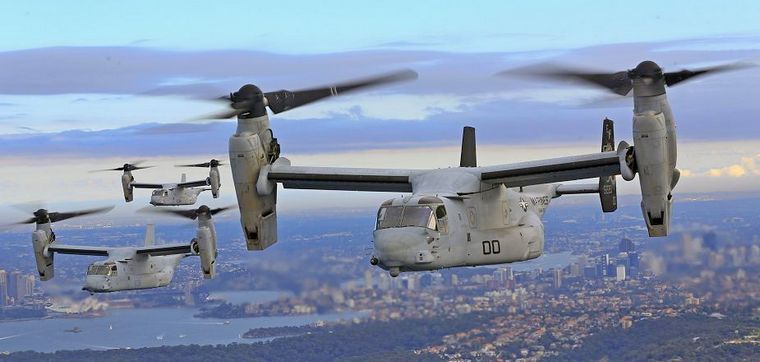 "The delivery of the first Japanese V-22 is an important milestone and represents our strong partnership with the Government of Japan," said Shane Openshaw, Boeing vice president of Tiltrotor Programs and Bell Boeing deputy program director. "The Osprey's ability to carry out the toughest missions in the most challenging operating environments will reshape what is possible for the Japan Ground Self Defence Force." Photo © Boeing Japan joins the United States Marines, Navy and Air Force in operating the V-22. These aircraft support multiple missions, including the transportation of personnel, supplies, and equipment; humanitarian support and search and rescue missions; long-range personnel recovery. With more than 500,000 flight hours, the V-22 is one of the most in-demand platforms in military aviation, providing safe, survivable, combat-proven mission success only capable with the tiltrotor range, speed and versatility of the Osprey.  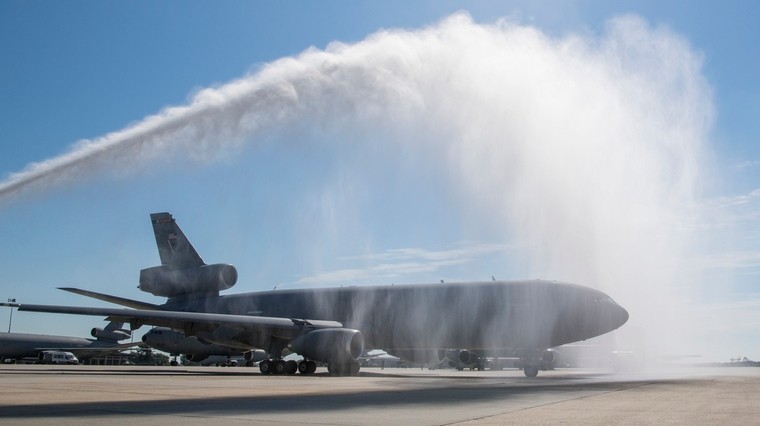 A KC-10 Extender receives a traditional water salute during a retirement ceremony at Joint Base McGuire-Dix-Lakehurst July 13. The plane, the first in the fleet to be retired as the Air Force brings on the new KC-46 Pegasus tanker, was then flown to the Boneyard at Davis-Monthan Air Force Base in Arizona by Lt. Col. Mike Pillion. (Air Force) At a ceremony held at Joint Base McGuire-Dix-Lakehurst in New Jersey, the first KC-10 to be retired was given the traditional final salute when it taxied under an arcing spray of water before departing to the 309th Aerospace Maintenance and Regeneration Group at Davis-Monthan Air Force Base in Arizona, more commonly known as "the Boneyard." This KC-10, tail number 86-0036 entered service in December 1986 and in its career spanning 30 years, has flown more than 33,000 flight hours, supporting missions across six continents and refuelling more than 125,000 aircraft from 25 different countries. She was also active during operations Desert Shield and Desert Storm.   KC-135 Stratotankers and an RC-130 Rivet Joint from RAF Mildenhall and NATO Airborne Warning and Control Systems also took part in the exercise, which was intended to let the allies practice interoperability, improve their readiness and deter potential adversaries. "Exercise Point Blank provides UK Combat Air the opportunity to operate alongside our [U.S. Air Forces in Europe-Air Forces Africa] colleagues in demanding, large scale air wars," RAF Air Vice Marshal Allan Marshall said in the release. This exercise tested "our ability to plan and coordinate across a number of dispersed units in multiple countries." The exercise, which is designed along with the RAF, is intended to prepare its pilots for tough battles against "near-peer adversaries," or nations with comparable levels of airpower. "These exercises are valuable for ensuring our airmen sharpen their combat readiness and increase tactical proficiency. We will continue to safeguard U.S. national interests and those of our allies and partners throughout this COVID-19 crisis, and these types of exercises ensure we can meet that priority." Col. Jason Camilletti, commander of the 48th Fighter Wing, said in the release.  HAWAII 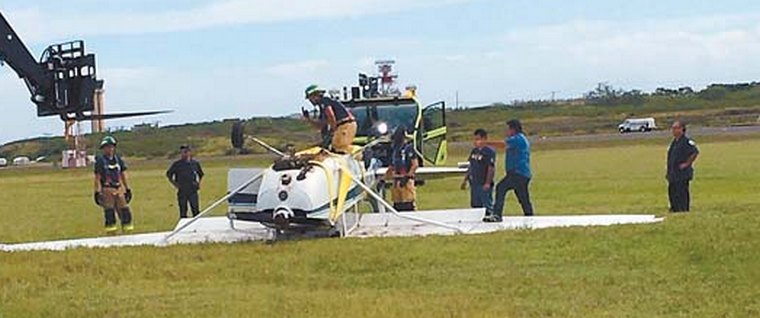 According to a report issued by the National Transportation Safety Board, student pilot Paula Whiteley of Makawao on 17 March 2020 failed to avoid the wake turbulence of a heavy jet while approaching the runway at Kahului Airport which resulted in loss of control and the Cessna172 flipped over onto its back. The student Paula Whiteley 50, suffered minor injuries in the nose-over landing on the main runway. The Cessna 172 had "substantial damage" to the right wing, lift struts and empennage, the crash factual report said. Photo © NTSA. RSA, Cape Town International Airport: A Eurocopter EC 120B operated by Cape Town Helicopters during a training exercise on landing ended up on its side. There were no fatalities. Kenya, Kanyonga, Masinga: A Kenyan Défense Force McDonnell Douglas MD 500E (369E) with two on board crashed during a training flight. There were no survivors. Namibia, near Heja Lodge: A MD Helicopters MD600N crashed under unknown circumstances. The pilot and three passengers were seriously injured. Turkey, SW of Van-Ferit Melen Airport: A Turkish Police Beechcraft B300 King Air 350i surveillance aircraft with seven on board impacted Mount Artos as it was returning to Van-Ferit Melen Airport in Turkey following a mission. There were no survivors. Brazil, Guarulhos Airport: A LATAM Brazil Airbus A319-100 on a flight from Aracaju to Sao Paulo Guarulhos with 77 passengers and 5 crew, was on approach to Guarulhos Airport when the flight crew performed a manoeuvre in manual flight to reduce the speed. A flight attendant, who was standing at the time, fell as result and received fractures to fibula and ankle in her left leg. The flight crew requested medical assistance and continued for a safe landing. The occurrence was rated an accident and is being investigated. Brazil, Viracopos Airport: An Azul Linhas Aereas Embraer ERJ-195 with 90 passengers and 5 crew on board on a flight to Porto Velho Brazil was climbing through FL280 out of Viracopos Airport when the crew declared PAN PAN reporting a low oil pressure indication for the right-hand engine. The engine was shut down and the aircraft returned to Viracopos for a safe landing. Brazil's CENIPA rated the occurrence an incident and did not open an investigation. The very same day another E195 of Azul suffered a similar failure. USA, Detroit: An American Airlines Boeing 737-800 on a flight from Dallas was on final approach to Detroit when the crew initiated a go around. However, the aircraft's aft belly contacted the runway surface. The aircraft climbed back to 5000 feet maintaining routine communication, positioned for another approach and landed on runway 04L without further incident about 15 minutes later. USA, Fort Lauderdale: Three female passengers from Philadelphia, all in their early 20s, were arrested after kicking, punching, tossing phones, food and shoes at five Spirit employees when their flight from Fort Lauderdale to Philadelphia was delayed. The incident was captured on video. All three were charged with battery, while one faced an additional charge of petty theft for taking one of the employees' cell phones and stashing it in her backpack.    Catalina seaplane Miss Macao (VR-HDT), operated by a Cathay Pacific subsidiary, with 23 passengers and 3 crew on board flying from Macau to Hong Kong is hijacked mid-way over the Pearl River Delta by a group of 4 hijackers attempting to rob the passengers on board. The pilot is attacked and loses control during the ensuing struggle in the cockpit. The subsequent crash kills all on board except one passenger, who was later identified as one Wong Yu, the lead hijacker. The object of the plot was to rob wealthy passengers and hold them for ransom. He was brought to court by the Macau police, but the Macau court suggested that the prosecution should be brought in Hong Kong instead, since the plane was registered in Hong Kong and most of the passengers were from there. However, the British colonial government in Hong Kong stated that the incident happened over Chinese territory in which the British had no jurisdiction. Since no state claimed authority to try him, Wong was released without trial from Macao Central Prison on 11 June 1951 and was then deported to China (by then the People's Republic of China). This is the first known case of airliner hijack.   |
                             |
 |
 |

Copyright © Pilot's Post PTY Ltd
The information, views and opinions by the authors contributing to Pilot's Post are not necessarily those of the editor or other writers at Pilot's Post.